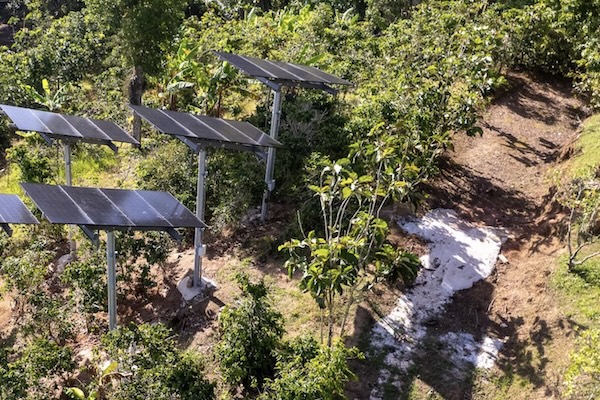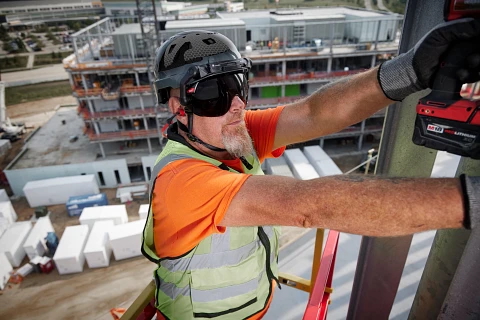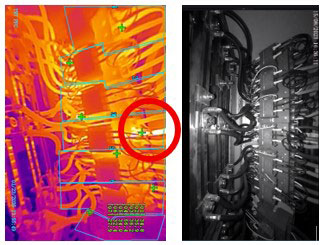Energy Storage
Schaltbau North America
Wind
Ole Binderup
Solar
Sun Ballast

As electricity demand surges to record levels across North America due to data center additions and general load growth, utilities and developers are under mounting pressure to deliver reliable power quickly and cost-effectively. Battery energy storage has become an essential solution for stabilizing the grid and supporting new generation, but even experienced teams can face costly setbacks when small project details are missed. To help the industry avoid those pitfalls, TruGrid, a leading engineering, procurement, and construction (EPC) and operations & maintenance (O&M) provider for energy storage and solar projects, has released a new article titled "5 Overlooked Details That Can Make or Break a Battery Energy Storage Project." The piece outlines practical ways developers and utilities can strengthen execution and safeguard project performance.
The article draws on TruGrid's real-world EPC experience across North America and highlights five critical yet often underestimated risks. It also provides actionable strategies that can be used to reduce risk and ensure smoother execution. These include:
Read the full article here: 5 Overlooked Details That Can Make or Break Battery Energy Storage Projects for Developers & Utilities
TruGrid | https://trugridpower.com/

Energy Vault Holdings, Inc. (NYSE: NRGV) ("Energy Vault" or the "Company"), a global leader in grid-scale energy storage solutions, announced its acquisition and planned development of SOSA Energy Center, a 150 MW/300 MWh battery energy storage system (BESS) located in Madison County, Texas. The project, originally developed by Savion, a subsidiary of Shell plc, represents a significant advancement in Energy Vault’s growing U.S. portfolio and marks the first project to be formally acquired through its Asset Vault investment platform.
The 150 MW/300 MWh BESS is positioned within the ERCOT North market, one of the most mature and dynamic power markets in the United States. The project is expected to receive Notice to Proceed (NTP) in Q4 2025, with commercial operation expected in Q1 2027. Energy Vault will safe harbor the asset with construction beginning on-site in Q4 2025. Upon completion, the project will deliver critical grid support and renewable integration capacity to Texas’s rapidly evolving energy landscape.
As the first project to be formally acquired under Energy Vault’s Asset Vault investment platform, the SOSA BESS acquisition will be supported by the recently announced $300 million preferred equity investment by Orion Infrastructure Capital (OIC), in addition to the monetization of Federal Investment Tax Credit-related funds. Asset Vault is a fully consolidated subsidiary of Energy Vault, dedicated to developing, building, owning and operating energy storage assets globally. Energy Vault is in advanced negotiations with a counterparty for an 8-year offtake agreement.
“The SOSA BESS is a strong addition to Energy Vault’s growing global portfolio of energy storage deployments, with top quartile project performance attributes consistent with all project acquisitions and development under the Asset Vault platform,” said Robert Piconi, Chairman and Chief Executive Officer of Energy Vault. “This project acquisition demonstrates our commitment to one of the most important attributes of success in this dynamic market -- speed of execution -- rapidly deploying capital toward the development of high-return, bankable energy infrastructure at scale.”
"SOSA represents the caliber of bankable, cash-flow generating assets that Asset Vault was designed to capture," said Chris Leary, Head of Infra Equity, OIC. "Energy Vault's proven ability to execute on projects with strong fundamentals and long-term revenue visibility reinforces why we're committed to supporting their growth as they build a portfolio of owned and operated energy storage assets that deliver predictable returns."
The SOSA project benefits from fully secured site control, clean title, and completed environmental and interconnection milestones, ensuring a streamlined path to construction. The offtake structure is expected to be underwritten by an investment-grade counterparty, and is expected to deliver bankable, frontloaded revenue streams, enhancing returns and de-risking project cash flows.
The BESS will leverage Energy Vault's third-generation B-VAULT™ AC product, enabling Energy Vault to deliver the system quickly and at low cost while also providing higher levels of system availability in the ERCOT region. The company’s global B-VAULT™ portfolio now exceeds 2 GWh of deployed or contracted systems, spanning Europe, North America, and Asia, and is complemented by Energy Vault’s gravity and hydrogen storage platforms for multi-duration energy applications.
Asset Vault creates a vertically integrated ecosystem that captures value across the entire energy storage lifecycle, combining Energy Vault's proven operational expertise with long-term asset ownership to generate predictable, recurring cash flows. Under Asset Vault, Energy Vault self-performs engineering, procurement, construction (EPC), and long-term service agreements for projects, creating multiple cash flow streams while maintaining the flexibility to optimize returns through strategic capital deployment. In addition to the SOSA BESS, current U.S. projects managed under the Asset Vault platform include the 57 MW/114 MWh Cross Trails BESS as well as the 8.5 MW/293 MWh Calistoga Resiliency Center, a hybrid energy storage system combining clean hydrogen with battery cells. Also managed under the Asset Vault platform is the recently-acquired 125 MW / 1.0 GWh Stoney Creek BESS, located in New South Wales, Australia.
For more details on Asset Vault, the company is scheduling a virtual Investor and Analyst Day on Wednesday October 29th, 2025. Registration details can be accessed here: https://www.energyvault.com/rsvpinvestorday2025
Energy Vault | www.energyvault.com

Embedded into a mountainside in Adjuntas, Puerto Rico, a new agrivoltaics system could set standards for energy independence in hurricane-prone regions. This system was realized through a collaboration between solar professionals, energy manufacturers, and a family-owned coffee farm. MT Solar is proudly included among its contributors.

Hacienda Berdiel Torres owner, Miguel Berdiel, was dealing with multiple obstructions on what should have been a prosperous farm. Despite optimal coffee-growing conditions and a hydroponic greenhouse, high energy costs and other impacts from Hurricane Maria were stifling growth. The greenhouse's hydroponics system was eventually shuttered, and plans to offer jobs and locally grown food to the community were halted.
Hacienda Berdiel's challenges and potential as an agrivoltaics research and climate resilience project aligned with the NREL's InSPIRE initiative. The organization tapped Oregon-based nonprofit, Twende Solar, to plan and coordinate the installation.
Twende Solar approached MT Solar to design top-of-pole mounts that could be safely and efficiently installed at a 3000-foot elevation and accommodate all farming operations. The system also needed to resist hurricane-level forces and provide enough capacity to secure Hacienda Berdiel's energy resources.
"With such high wind loads, we had to tackle some challenges to get a design that allows for high ground clearance above coffee trees. It's exciting to help our customers achieve their needs even in extreme conditions," Jamie Blum, MT Solar's design and sales engineer, explained.
The 9.8kW system was installed in July of 2025. MT Solar subsidized six solar mounts, each holding four 410W modules 15 feet above the ground. Aireko Energy Group and GRID Alternatives Puerto Rico completed the foundation and system assemblies. Texas-based energy storage manufacturer, EG4 Electronics, donated the inverter and batteries for a 40kWh energy bank.
With the system running, Hacienda Berdiel now plans to reopen its greenhouse. Despite energy costs and an unpredictable climate, energy resilience and independence are within its reach.
This system could define standards for ground solar in hurricane-affected regions. To help build a blueprint for comparable installations, researchers will monitor system output and crop productivity over the next two years.
MT Solar | https://www.mtsolar.us/

With X.Cellify DC, Dürr has developed a new kind of dry coating for electrodes: a free-standing film of active material is created that is 100% recyclable until it is laminated onto the collector foil. This significantly reduces active material waste. The proof of concept for the process shows that the technology works reliably and is scalable. This paves the way for pilot projects on a gigawatt scale – initially for lithium-ion batteries and, in the future, for solid-state batteries as well.
Electrode production has so far relied almost exclusively on wet coating, in which the cathode and anode material is applied as a solution to metal foils and then dried in an energy-intensive process. The technology developed by Dürr in collaboration with partners does not require solvents or drying ovens, as it produces the electrodes from a dry powder mixture. The dry battery material is pressed into a film using the Activated Dry Electrode® process by development partner LiCAP Technologies. The new X.Cellify DC development covers all process steps – from dosing, film formation, and densification to lamination onto the collector foil.
Less energy, less production space
Dry coating offers clear advantages over conventional wet coating in electrode production: it reduces space requirements by up to 65% and lowers energy consumption by up to 70%. These savings are mainly due to the elimination of dryers and solvent recovery. "The successful proof of concept is a major step forward for us. We have demonstrated that the new kind of dry coating with free-standing film works reliably and delivers consistently good quality. It can be scaled up, making it the basis for initial pilot projects in industry," explains Bernhard Bruhn, Vice President of Dürr's Global Business Unit LIB. The process is suitable for today's lithium-ion batteries and also for solid-state batteries.
Free-standing film reduces scrap
The proof-of-concept plant is located in Chassieu in southern France, in a dry room environment at Ingecal, a Dürr Group company specializing in calender technology. Calenders are machines with rollers that compress materials into an even layer. Dry coating starts with film formation: A horizontal calender forms the dry powder into a film. It is referred to as “free-standing” because it runs through the machine without a carrier foil. In the second step, additional calenders compress the film to the desired layer thickness, density, and porosity. Finally, one film is laminated onto the collector foil from each side – thus producing the electrode. “Since we don't need a carrier foil until the final step, we can return the film to the process in its entirety if it does not meet the desired specifications. Thanks to the closed loop, no valuable active material is lost and we significantly reduce waste – an important point in battery production,” explains Bruhn.
Improved further processing
The special characteristic of X.Cellify DC lies in its web guidance: the system transports the free-standing film in a self-supporting manner and compresses the film before it is applied to the current collector. The subsequent lamination onto the current collector requires less force than calendering in the wet coating process, which means that the foil does not deform – improving its processability for the downstream process steps of notching and stacking.
Combined strengths
The new approach to dry coating combines Dürr's expertise in electrode manufacturing and system integration, Dürr Ingecal's high-precision calenders, and LiCAP's patented Activated Dry Electrode® technology. “To take the next step, we are actively seeking pilot partners in the industry for gigawatt-scale projects. This will enable us to bring the technology into real production environments – whether for electric cars, stationary storage or other applications,” says Bernhard Bruhn. Dürr is thus ready to partner in the next generation of battery production – with solutions for wet and dry coating.
Dürr Systems | www.durr.com

Vikram Solar, one of India’s leading solar PV module manufacturers, has announced a major order of 148.9 MW high-efficiency solar modules from Sunsure Energy, a leading renewable energy solutions provider for India’s leading businesses and utilities transitioning to green power. The modules, rated at 595 Wp, will be deployed across Maharashtra and Uttar Pradesh, two states that are playing a pivotal role in advancing India’s clean energy ambitions.
Under this contract, Vikram Solar will supply its advanced M10R N-Type TOPCon modules to Sunsure, known for superior efficiency, reliability, and high energy yield.
This order from Sunsure Energy adds to a series of significant wins for the company this year, including 200 MW from AB Energia, 336 MW from L&T Construction, and 326 MW from Gujarat Industries Power Company Limited, among others.
Mr. Gyanesh Chaudhary, Chairman & Managing Director, Vikram Solar, said; “India recently crossing the 125 GW renewable energy capacity mark is a powerful reminder of the momentum we’ve built on our clean energy journey. We are moving swiftly and decisively toward our national goals, and collaboration with Sunsure Energy play a vital role in sustaining that progress. By combining technological excellence with strong industry partnerships, we are not just accelerating project execution but also strengthening the collective ecosystem that will power India’s clean energy future.”
Manish Mehta, Co-Founder & Chief Commercial Officer at Sunsure Energy said, “At Sunsure, our mission is to empower India’s industries with reliable, round-the-clock green energy by building large-scale renewable plants equipped with superior-quality modules and advanced BESS technologies, while upholding the highest standards of operational excellence. Partnering with Vikram Solar for our upcoming projects in our key markets - Uttar Pradesh and Maharashtra, reflects our commitment to integrating world-class technology with efficient execution. Their proven track record and manufacturing excellence align with our performance goals. Together, we aim to deliver clean energy at scale across India and contribute meaningfully to India’s ambition of achieving 500 GW of clean energy capacity.”
The project supports India’s target of achieving 500 GW of non-fossil fuel capacity by 2030, while also driving local economic impact through clean power access, reduced carbon emissions, and enhanced energy security.
Vikram Solar | https://www.vikramsolar.com/
Sunsure Energy | www.sunsure-energy.com

Bluewater, a global service provider in battery and solar equipment lifecycle management, announces a year of robust growth, highlighted by significant new achievements across its core business divisions. Over the last 12 months Bluewater has:
Bluewater’s operations also grew globally, expanding its footprint to four additional countries, Italy, Hungary, Spain, and Poland, bringing its total to 19 countries served worldwide. This global reach strengthens Bluewater’s ability to deliver rapid, compliant, and sustainable solutions to a diverse international client base.
The strongest area of growth was demonstrated by Bluewater’s Solar Division, which responded to surging demand in the second-life equipment market. Utility-scale solar energy plants increasingly rely on Bluewater to source and deliver matching equipment, including surplus solar panels, inverters, converters, and BESS containers, helping keep their systems online, reduce downtime, and avoid costly project delays.
“Our results this year reflect both the growing need for circular solutions in clean energy and the trust our partners place in Bluewater,” said Ben Firestone, CEO of Bluewater. “By adding 25 MW of decommissioned battery storage, 1 million pounds of recycled batteries, 380 MWh of repurposed batteries, and 200 MW of remarketed solar panels, we’re enabling our customers around the world to maximize asset value and maintain momentum toward sustainability goals.”
Bluewater’s end-to-end, compliance-driven approach to battery and solar equipment management continues to set the industry standard, delivering tailored solutions for a wide range of U.S. and international customers.
Bluewater | https://www.bluewaterbattery.com/

Managing the land used to host solar energy projects with conservation practices can be a tool for good land stewardship, offering economic and ecological benefits. The Center for Rural Affairs has released a fact sheet, “Unlocking the Dual Benefits of Solar Energy and Conservation Practices,” that analyzes the dual benefits of solar energy and conservation practices.
Conservation practices are methods used to manage, protect, and restore natural resources, often by minimizing erosion and enhancing biodiversity for long-term ecological health. These practices can be implemented on land being used to host solar projects.
“Solar energy development is often viewed as a threat to various land use practices, but it can actually work alongside them,” said Cora Hoffer, senior policy associate at the Center for Rural Affairs. “Implementing conservation practices on the land under solar panels can improve soil health, and support wildlife and pollinator habitat. It can also offer financial support to farmers and landowners through land-lease revenue or cost savings from on-farm electricity generation.”
Exploring the opportunity to site solar projects on land enrolled in federal conservation programs, like the Conservation Stewardship Program and Environmental Quality Incentives Program, could allow landowners to demonstrate good land stewardship while continuing to generate income.
Several land management practices that can be implemented at solar sites are supported by federal conservation programs, such as grazing livestock to manage vegetation and planting pollinator-friendly species to provide habitat and stabilize soil. Additionally, shade created by solar panels cools the soil and reduces water loss, potentially improving yields and plant quality.
“Rather than viewing solar energy and ecological stewardship as having competing interests, combining them offers a forward-thinking approach to sustainable land-use,” said Hoffer. “It presents an opportunity to address growing energy demand and conservation efforts, while providing financial benefits to farmers and landowners.”
The fact sheet is available in both English and Spanish.
Center for Rural Affairs | cfra.org/publications
Solar Oct 10, 2025
Solar is safe when it’s maintained — and risky when basics slip. Across sites, the pattern behind many PV fires is consistent: soiling and shading create hot spots; loose or corroded DC joints run hot; wildlife and litter add fuel; and moisture i....



Solar is safe when it’s maintained — and risky when basics slip. Across sites, the pattern behind many PV fires is consistent: soiling and shading create hot spots; loose or corroded DC joints run hot; wildlife and litter add fuel; and moisture i....
As utility-scale hybrid solar and battery energy storage projects become standard across North America, operators are facing increasing complexity. These systems are no longer passive generators, but dynamic assets that must respond in real time to g....
It didn’t start with a robot. It started with a problem. Clean energy is one of the hottest commodities today, and the world is rushing to meet this increasing demand. However, the typical financial barrier isn’t a problem for the industry; it....
Wind power has been a highly successful ....
As wind turbines keep growing taller and....
As energy needs grow more complex and grid instability becomes a regular concern, mobile microgrids are gaining attention as a flexible, lower-emission energy solution. Their emergence is timely. From wildfire-related outages in the West to hurricane....
A next generation of Virtual Power Plants has emerged in 2025, embodying trends which will require more efficient integration with utility grids. These trends span a wide range: VPPs that integrate EV charging and other new resources; building manage....
The confluence of several energy challenges has presented itself within the North American market. Rising electricity demands, grid reliability concerns, affordability and bottlenecks have reached an inflection point. Microgrids are emerging as a sol....
After months of debate in Congress, the One Big Beautiful Bill Act (OBBBA) was finally signed into law. With the goal of restructuring and simplifying federal incentive programs while reducing long-term costs, the OBBBA comes with several updates and....
Helium, once known primarily for its niche industrial uses, has emerged as a strategic political asset amid rising geopolitical tensions and trade uncertainties. Its critical role in next-generation technologies such as semiconductors, space explorat....
The need for reliable, high-quality electricity has never been greater now the grid is highly dependent on getting its supply from multiple sources. Power grid quality monitoring increasingly plays a significant role in ensuring that electricity arri....